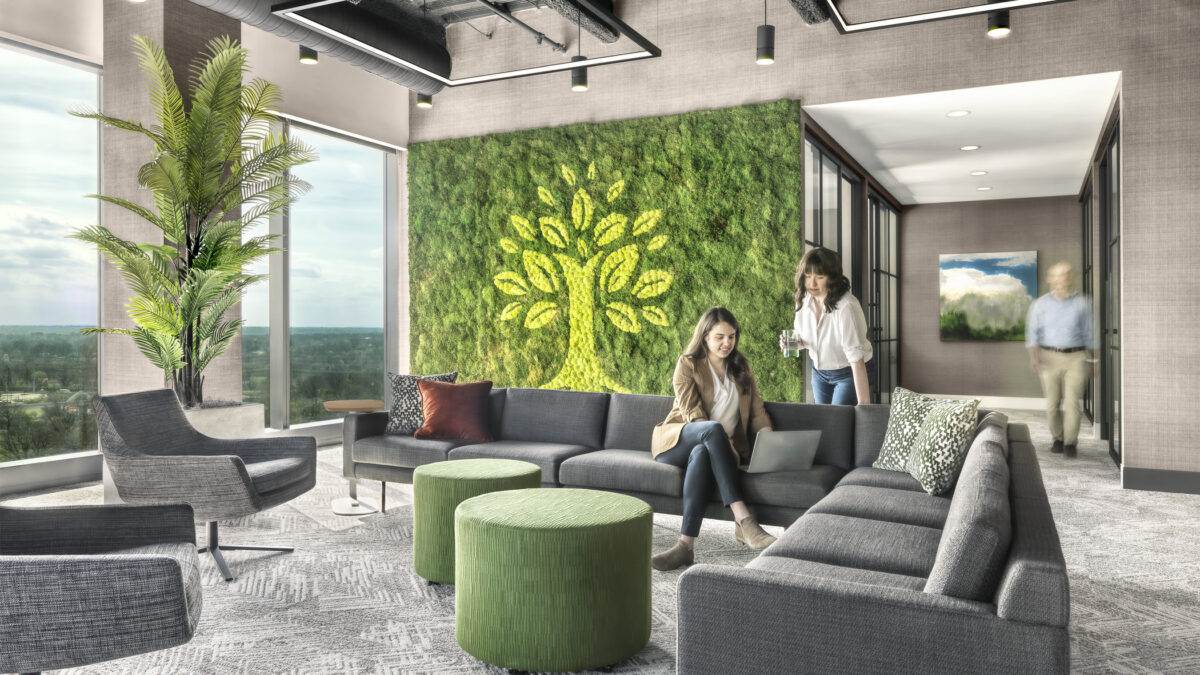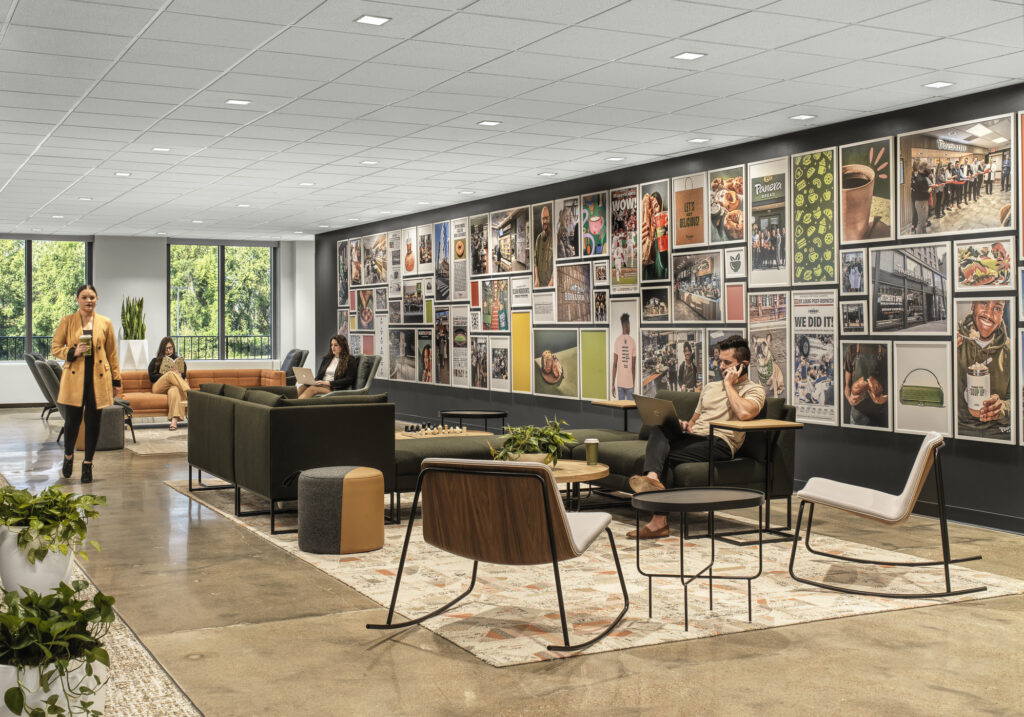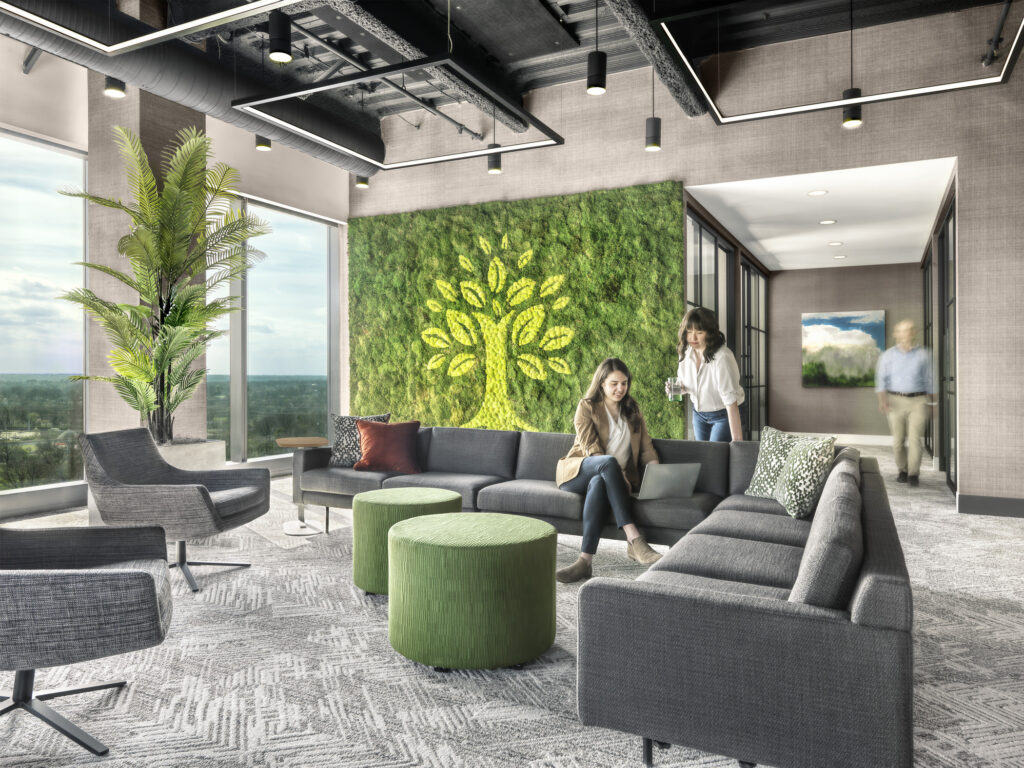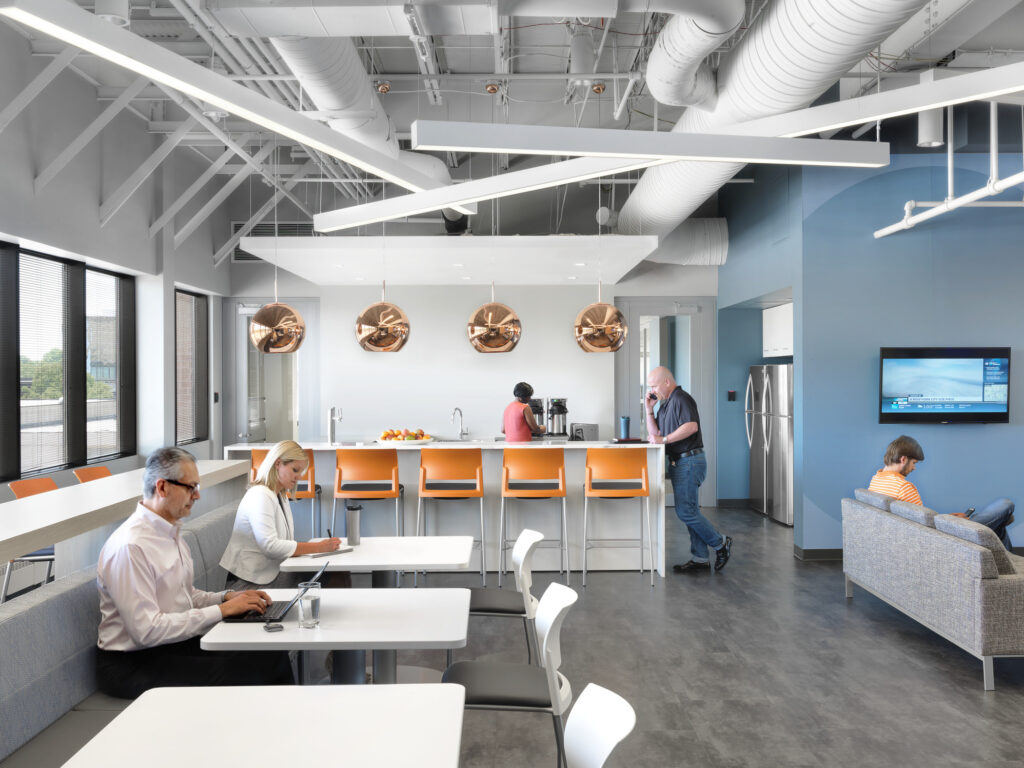Office design trends for 2025 include free desking, task-based zones, “Zoom rooms,” work cafés, biophilic accents

The latest trends in office design reflect employers’ desire to entice workers to come to productive, collaborative environments that can’t be replicated in a home office.
While companies tout the cultural and collaborative benefits of return-to-office, some workers remain hesitant to give up their work-from-home lifestyles. The 2025 trends in office design focus on crafting spaces that function better than a home office, making it possible for employers to attract and retain the best talent for in-office and hybrid roles.
Below are 11 trends in office design for 2025 and beyond, according to Lawrence Group Workplace Market Leader Sharon Henderson, NCIDQ.
1. Free desking replaces assigned spaces
Free desking, also known as hot desking, is not a new concept, but it has exploded in popularity since the pandemic.
For the past few years, many knowledge workers have split their time between the office and home. This left traditional offices with a daily supply of dedicated-but-unoccupied desks. In free desking, workers share a desk with colleagues or simply claim an open workstation while they’re in the office.
This trend is characterized by fewer workstations than employees. This works because there is virtually no time the company expects all of its workers to be in the office at the same time. Free desking offers workers more flexibility in where and how they work, while allowing employers to reduce their office footprint without displacing anyone.
2. Paperless offices lead to less storage
Paperless offices are also helping companies to shrink their real estate footprint. Cloud-based digital storage has made the bulky file cabinet a thing of the past. This reduced reliance on paper means a reduced need for office supplies and the spaces that store them.
Storage rooms once dedicated to shelves of copy paper and toner can now be repurposed into more useful space. Copier rooms and file rooms can be renovated into workspace, small-group rooms, or quiet spaces to take a break.
3. Offices are dividing into task-based zones
Task-oriented office design features flexible spaces built to accommodate activities to be done. It marries the versatility of open-design floor plans with private offices’ ability to reduce distractions. For example, a task-based office might have specified distraction-free zones, collaboration zones, rest spaces, and meeting areas.
Workers can maximize their productivity by working in the environment best suited to the task they want to accomplish.
4. Right-sized spaces replace big offices
Businesses are focusing on both environmental sustainability and the bottom line. Both of these objectives are served by making efficient use of space. Workstations, collaboration spaces, conference rooms, and offices are being right-sized to fit the work done there and the culture of the organization.
“Right sizing” evaluates group and individual tasks by understanding who and how many people use a space at any given time and what physical features are required to accomplish each task. Then applying this knowledge to designing spaces that are just the “right size”.
In some cases, this requires a modular approach. Moveable walls and acoustic dividers can quickly split an open space into distinct rooms for collaboration, focus or engagement. Offices can use their space efficiently, adapting it as needs and team dynamics change.
5. Hybrid rooms accommodate hybrid workers
In 2023, almost two-thirds of knowledge workers reported working from outside the office at least once a week. As hybrid schedules become the norm, companies must adapt.
“Zoom rooms” offer workers a way to meet virtually with clients and colleagues in a more professional environment than their home office. A small office equipped with good lighting and integrated technology ensures high-quality video for virtual meetings. Strategically placed furnishings within the small office provide efficient use of space and ideal technology hardware locations.
A branded back wall imparts a sense of professionalism and corporate identity, while sliding glass doors reduce background noise for those in the meeting and those working outside the office while reducing the potential claustrophobic feeling of a smaller physical office.
Making it easy for hybrid workers to get work done onsite makes coming into the office a productive and enjoyable experience by providing the privacy and focus space found in a home office.
6. Smart buildings are reducing energy costs
Integrated technology can drastically improve an office’s energy efficiency. When areas of the office aren’t used from 9 a.m. to 5 p.m. every day, occupancy sensors conserve energy by automatically adjusting lighting, heating and cooling systems.
Integrated technology also aids in seamless collaboration with colleagues at offsite locations. Fast Internet connections and integrated audiovisual systems help make virtual meetings as productive as in-person gatherings.
Ensuring any problems are fixed before they cause a disaster, intelligent maintenance systems monitor the building’s performance and can alert management to opportunities for preventive maintenance. Smart buildings benefit the bottom line through energy savings and preventive maintenance, while promoting collaboration between onsite and offsite teams.
7. Sustainable offices take center stage
Sustainability can have a surprisingly strong impact on a company’s ability to attract and retain talent. A 2023 report found 90% of office workers believe a sustainable workplace is good for both people and planet, with 34% rating a sustainable office a “must have.”
Sustainable building practices are more mainstream and affordable than they have ever been. These include using natural, renewable, or recycled building materials, conserving energy through smart devices, and strategically laid out spaces to maximize daylight for all employees, and providing water refill stations to discourage the use of single-use plastic bottles.
Companies that want to go a step farther are taking sustainable office design out to the parking lot. They’re encouraging workers to travel green by providing bike racks, shuttles to public transit, and charging stations for electric vehicles.
Incorporating sustainability into office design reduces the environmental impact of the building and helps build a positive brand image.
8. Inclusive design ensures everyone feels welcome
There is a rising trend of awareness among corporate leadership of the diverse needs of the workforce. Businesses are working to attract and retain talent by demonstrating their commitment to making every employee comfortable.
Some inclusive design features, such as ADA accessibility and lactation rooms for nursing mothers, are required by law. There is a growing interest in incorporating additional inclusive spaces not yet required by law – such as gender-neutral bathrooms and quiet spaces for meditation or prayer.
Organizations that prioritize inclusivity are 35% more likely to achieve financial success, according to a McKinsey study.
9. Designs promote opportunity for physical activity
Ergonomic office design strives to reduce workplace injuries that happen over time due to sedentary tasks and repetitive motions. Offices designed to promote physical activity have healthier, happier employees and lower rates of absenteeism.
Task-oriented working spaces may include a mix of traditional desks, sofas and lounge furniture, allowing workers to stretch and work in varying postures. Other active design elements include walking trails, treadmill desks, ball or bike chairs, and adjustable height desks that allow workers to sit or stand.
Promoting physical activity and offering employees the chance to get out of sitting in the same posture all day reduces the risk of ergonomic injuries and missed work days.
10. Biophilic design brings the outdoors in
Biophilic design is a top trend in office design – particularly among people who spend most of their time indoors. One report found biophilic design improved productivity and creativity by as much as 15%.
Biophilic design brings elements of the outdoors inside. Examples include living or preserved walls, green roofs, and decorating with natural materials like wood and cork. These features create a sense of serenity and well-being, counteracting the negative effects of stress.
Designing offices to maximize natural daylight is a biophilic approach that has been shown to reduce incidences of eyestrain and headaches in employees. Workers also report feeling more alert and in a better mood when their environment lets in natural light.
Biophilic design promotes productivity, creativity, and well-being. Maximizing natural light as part of the office design can also reduce energy consumption due to lighting.
11. The office cafeteria is now a work café
In their bid to make the office a more attractive place to be, some organizations are blurring the line between work and leisure. Work cafés create the sense that work and relaxation are not mutually exclusive.
A barista-style coffee kiosk in the reception area creates a warm first impression for staff and visitors alike. It offers workers a place to stop and socialize throughout the day.
Bars are another trending dining option in the modern workplace. From traditional cocktail and wine bars to alcohol-free mocktail and juice bars, they offer a casual space to chat and collaborate.
Booth seating, informal farm tables, and lounge seating incorporated into an eclectic work café provides options for informal work conversations as well as focused work.
Work cafés and onsite bars promote social interaction between employees. They can also serve as a sophisticated setting for client meetings.
Whether they’re working in-office or at home, there is no question that the volume and quality of employees’ work is affected by their environment. Companies competing for the best and brightest in the knowledge economy must be able to offer a comfortable setting where workers can do their best work.
Learn more about Lawrence Group’s workplace designs.



